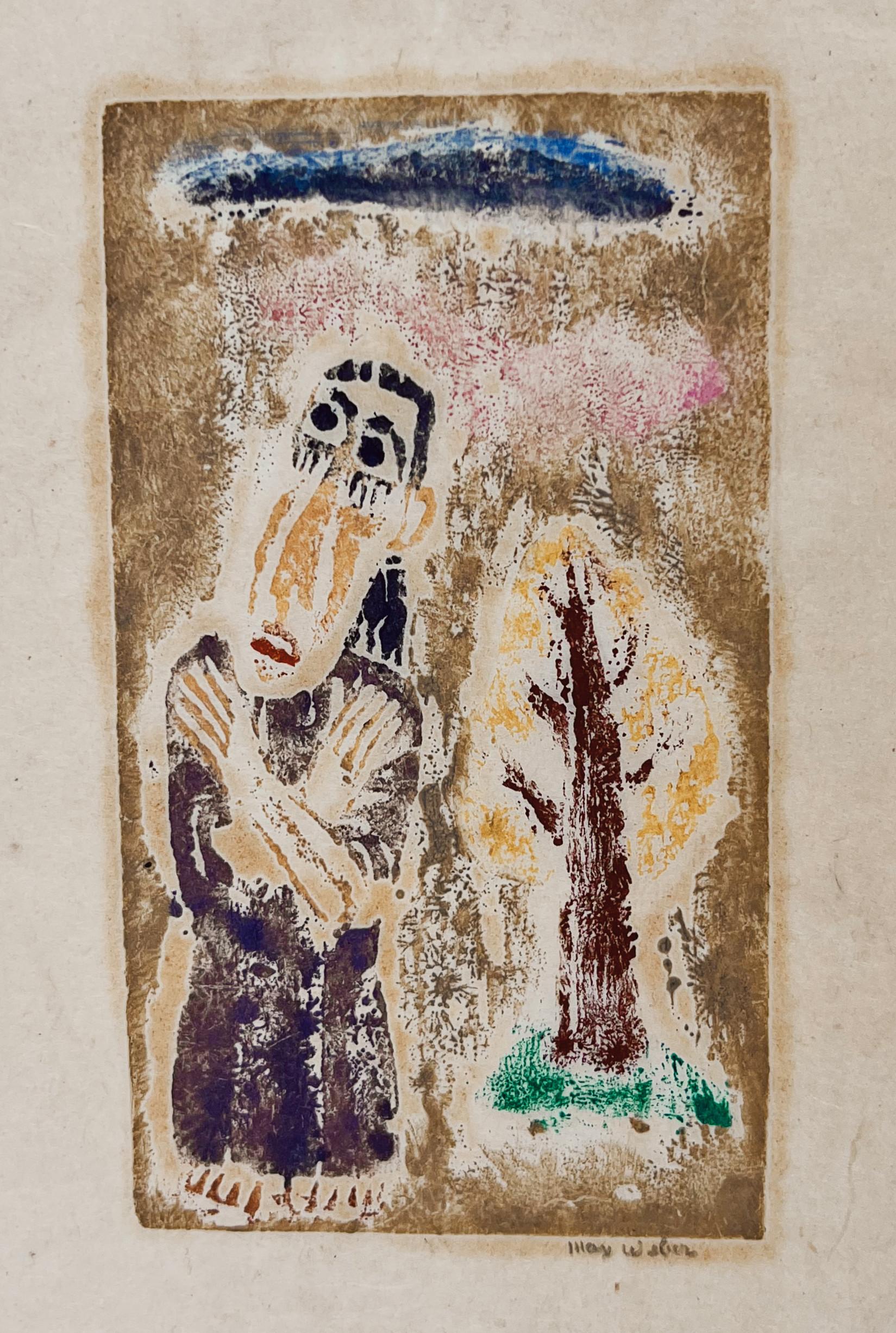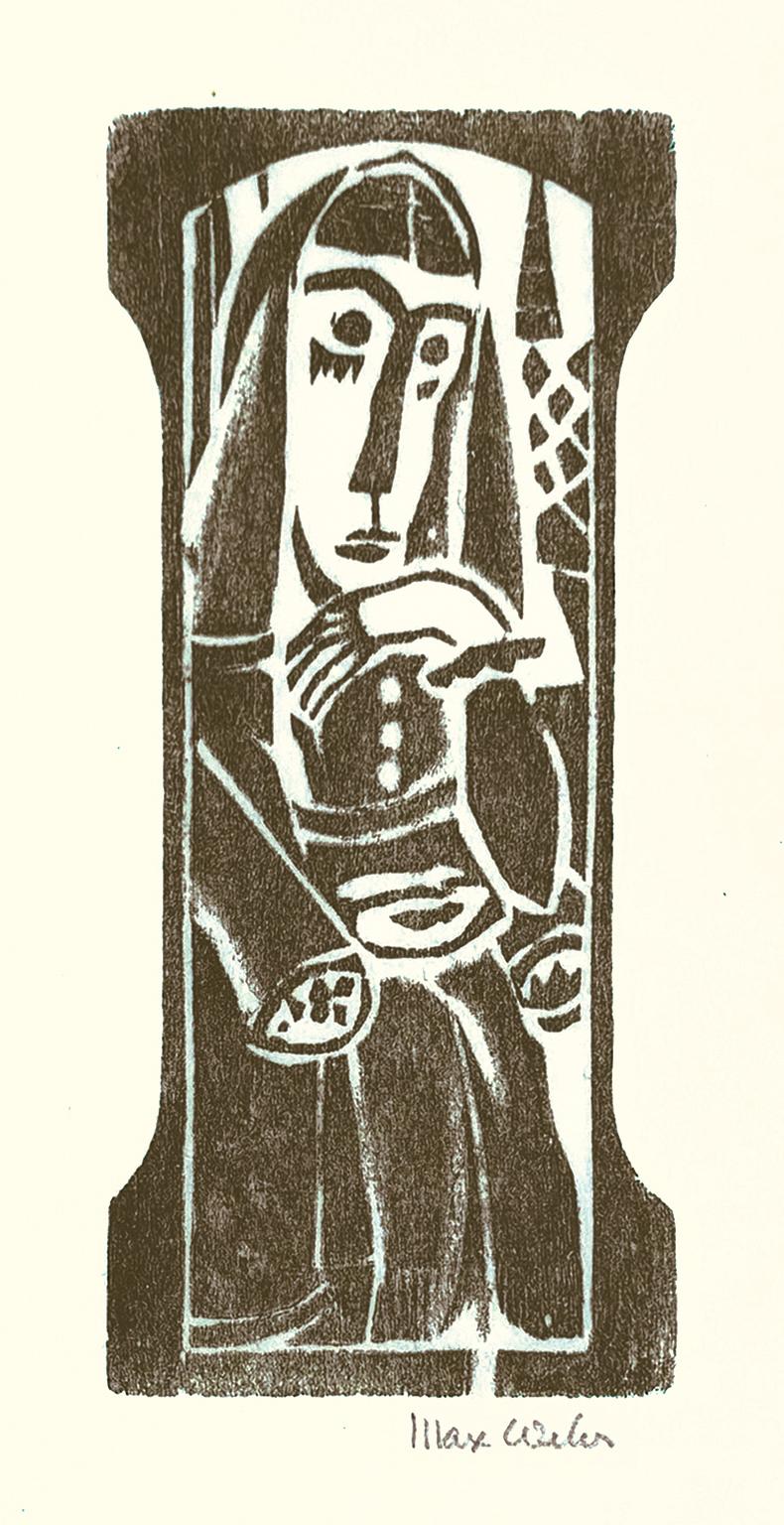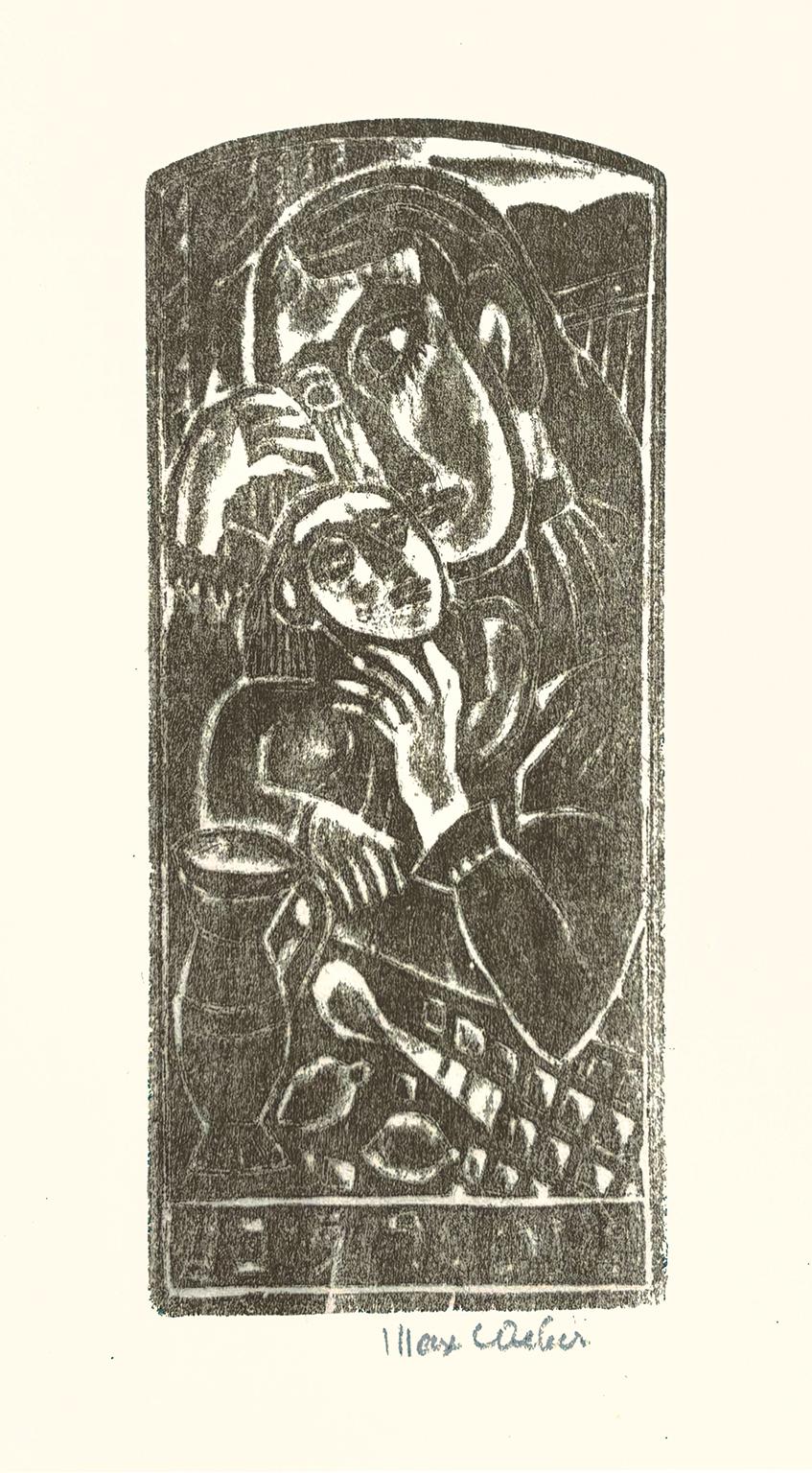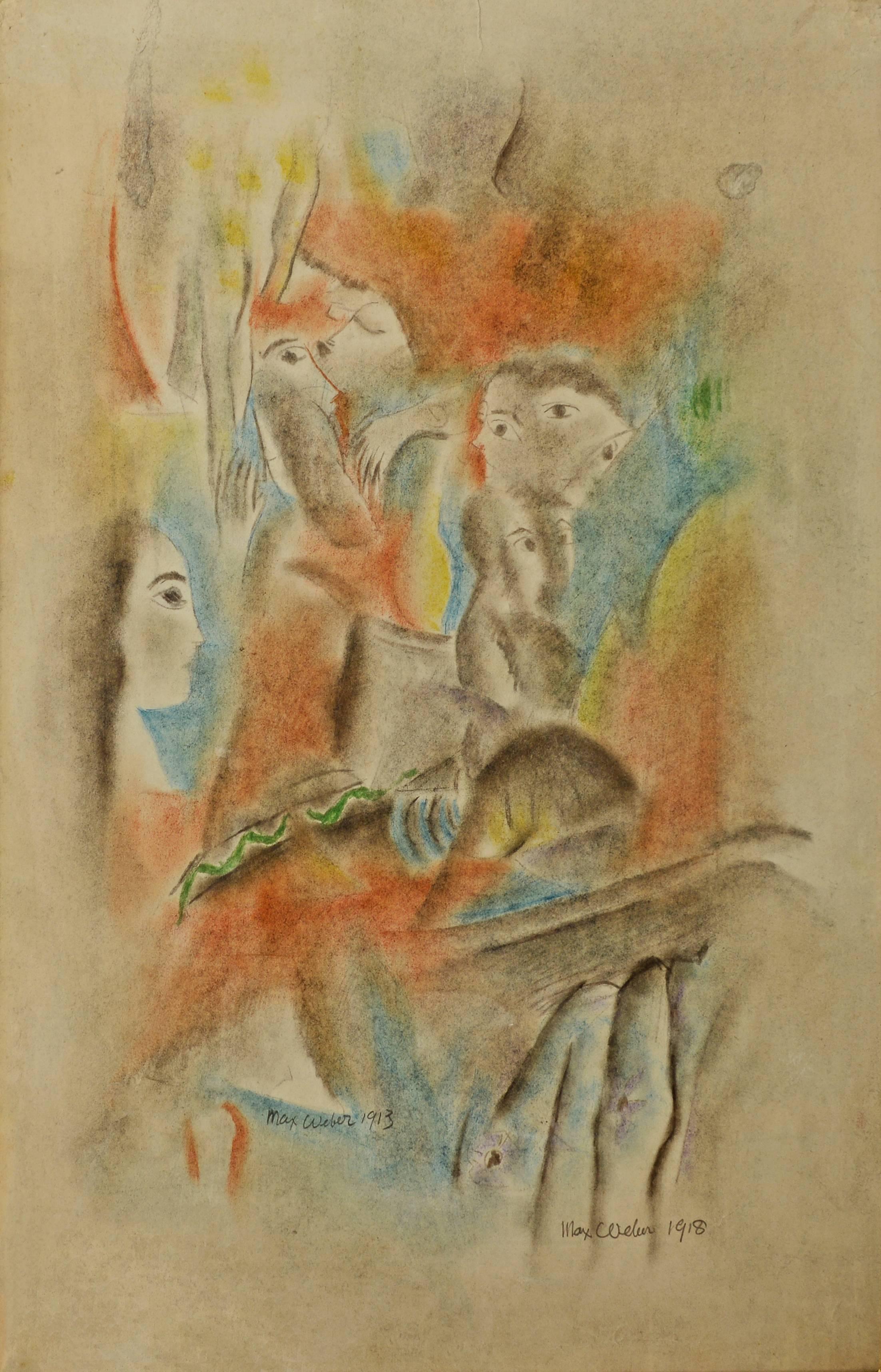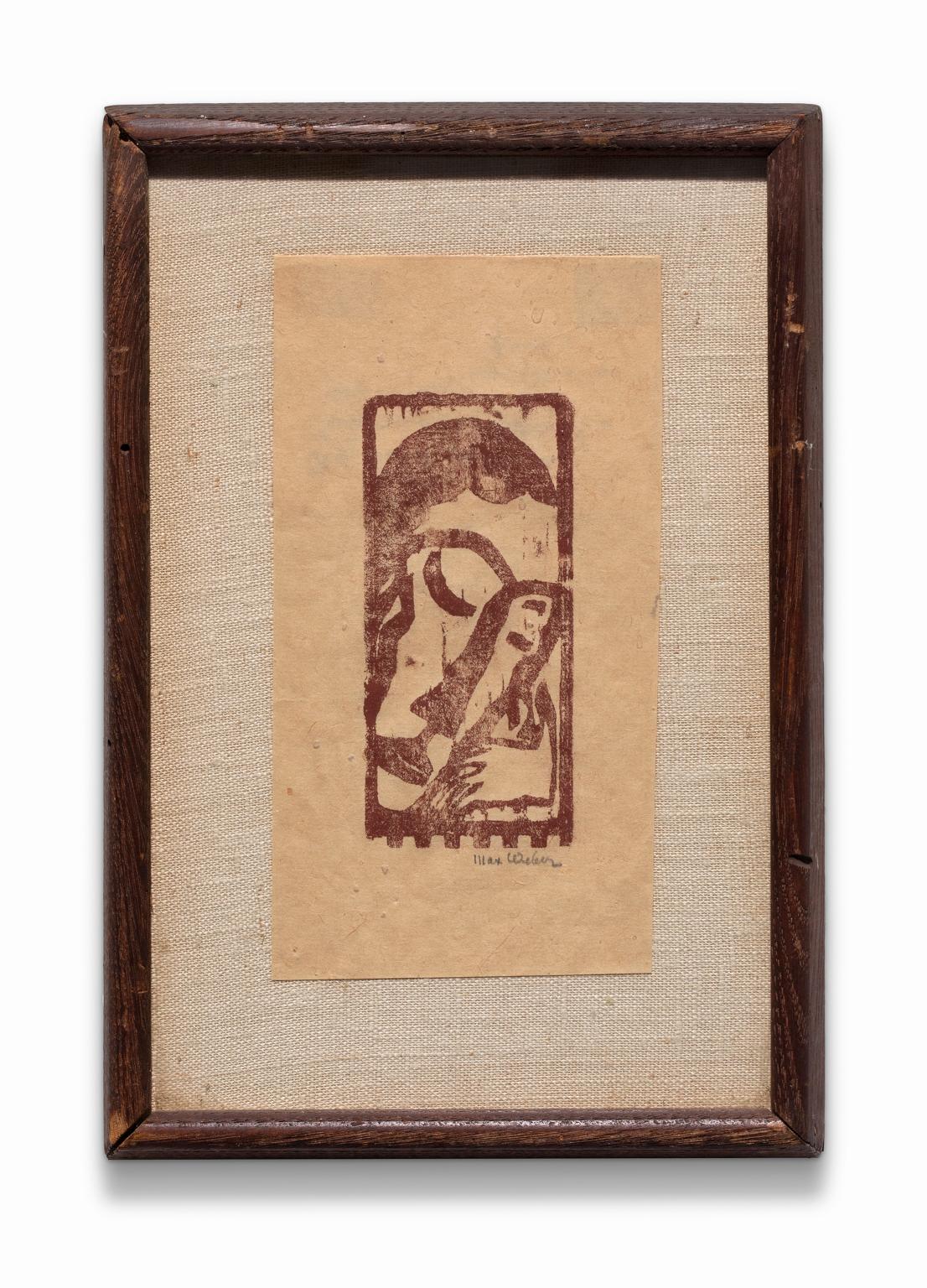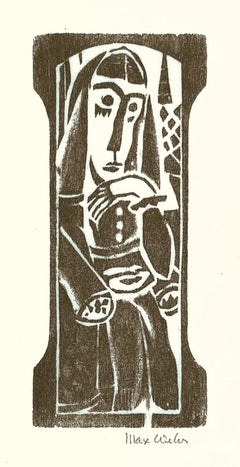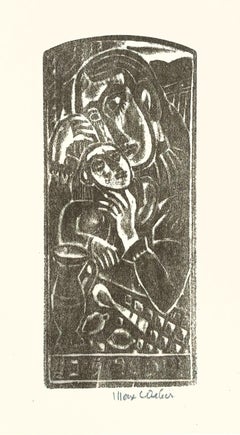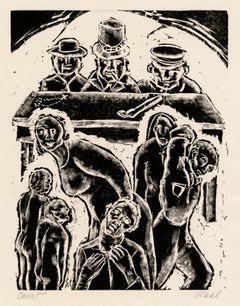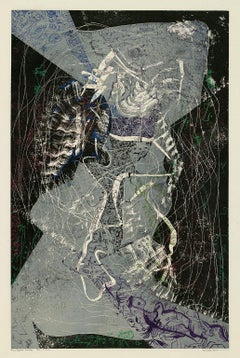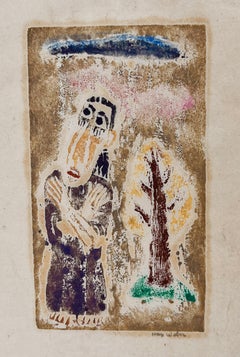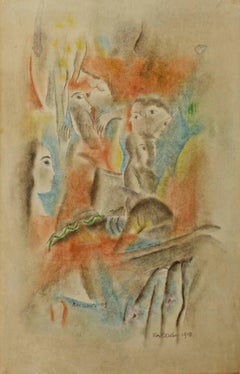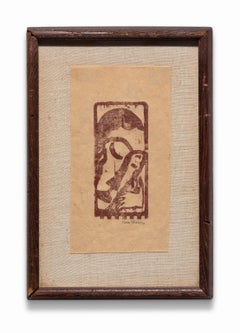Items Similar to 'Feast of Passover' — American Expressionism
Want more images or videos?
Request additional images or videos from the seller
1 of 3
Max Weber'Feast of Passover' — American Expressionism1920
1920
$2,000
£1,551.98
€1,752.29
CA$2,861.81
A$3,122.76
CHF 1,615.62
MX$37,357.60
NOK 20,409.11
SEK 19,163.83
DKK 13,086.50
About the Item
Max Weber, Untitled 'Feast of Passover', woodcut, 1920, edition proofs—this impression from the edition of 25 printed in 1956, Rubenstein 30. Signed in pencil. A fine impression, on cream Japan paper; the full sheet with wide margins (1 1/2 to 4 1/4 inches), in excellent condition. Image size 5 x 5 15/16 inches (127 x151 mm); sheet size 12 1/2 x 9 inches (318 x 229 mm). Scarce. Matted to museum standards, unframed.
Printed, at the artist’s request, by Joseph Blumenthal, The Spiral Press, New York. Included in the suite 'FIVE PRINTS BY MAX WEBER' published by Erhard Weyhe, director of Weyhe Gallery Inc., the renowned New York gallery established in 1919 to specialize in fine prints.
Collections: Brooklyn Museum, Detroit Institute of Arts, National Gallery of Art, Los Angeles County Museum of Art, Metropolitan Museum of Art, Museum of Modern Art, Philadelphia Museum of Art, Smithsonian American Art Museum.
ABOUT MAX WEBER'S RELIEF PRINTS
"In summary, Weber’s relief prints cannot be called just primitives or cubist forms. No single stylistic term is a satisfactory label. Collectively they suggest some common denominators: independence from academic traditions, interest in the element of design rather optical realism, simplicity and unpretentiousness in execution, craftlike tradition underlying their formulation and the desire to eschew the exactitude and dryness of wood engraving for the imprecision and painterly of hand-blocked work. The work was not a conscious effort at naiveté or lack of sophistication; on the contrary, it was an attempt to approach the origins of art.
ABOUT THE ARTIST
"To fill eternity with the ripest and the sanest expression of our consciousness is the essence as well as the purpose of life.” —Max Weber
Max Weber (1881-1961) was born in Bialystok, western Russia. When he was ten, his family came to America, settling in Brooklyn. While enrolled at nearby Pratt Institute from 1898 to 1900, he was a student of the modernist artist and influential teacher Arthur Wesley Dow who advocated for art as self-expression rather than traditional ornament.
Weber became an art teacher, first in the public schools in Lynchburg, Virginia, and beginning in 1903 at the Minnesota Normal School in Duluth. Inspired by Dow’s experience, Weber longed to continue his studies in Europe, and after years of prudent saving, he traveled to Paris in 1905.
He became a devoted disciple of Paul Cézanne, and met Guillaume Apollinaire, Robert Delaunay, Pablo Picasso, and Leo and Gertrude Stein. He became close friends with Henri Rousseau, later organizing the first exhibition of Rousseau’s work in the United States. A pupil of Matisse in 1908, he was deeply affected by the great artist’s expressive freedom and boldness of color. In recognition of his gifted assimilation of these many influences, one of Weber’s paintings was accepted for exhibition at the prestigious Salon d’Automne in 1907.
Weber returned to New York and had his first one-man show at the Haas Gallery in April of 1909, revealing himself as one of America’s earliest modernist artists. Although, as might have been expected, his cutting-edge work was mostly misunderstood and widely criticized, the show introduced the artist to Arthur B. Davies, who became a supporter and friend. Weber credited Davies with teaching him lithography in 1916, which enabled him to produce some of the earliest American modernist lithographs.
In 1919 Weber created his first group of woodcuts, many in color, which was exhibited in 1920 at the Montross Gallery in New York. Davies purchased some of the works, and the esteemed critic and gallery director Carl Zigrosser took other prints to sell at the Weyhe Gallery. That spring, ten of Weber’s poems with ten woodcuts were published in the Yiddish literary journal 'Schriften'. These early figurative abstractions display Weber’s unique melding of Cubist vernacular with primitivist sensibilities and stand among the most avant-garde American prints of the first quarter of the 20th century.
Weber’s subsequent relief prints represented Jewish themes, reflecting his heritage and spiritual convictions. Some of these works, such as ‘Feast of Passover’, expanded the artist’s repertoire to depict the interplay of multi-figure groupings. Weber’s prints were frequently reproduced in small literary magazines, and his book 'Primitives', published in 1926, integrated his poetry with his woodcuts.
Weber’s friendship with William Zorach, and an exhibition of the Provincetown printmakers in 1916, inspired his return to color relief prints. During 1919 and 1920, Weber created some thirty block prints—distinguished by their original use of color applied in a painterly manner, each impression being virtually unique.
In 1925 the artist taught at the Art Students League, New York. From 1928 to 1933, he produced thirty-four black ink lithographs printed from zinc plates. Many of these works demonstrated Weber’s continuing interest in using figurative groupings to explore his Zen-like approach to what he described as “the problem of form, balance of volume and sculpturesque spacial values.”
In 1930 Weber began to receive institutional recognition for his innovative work. That year, the Museum of Modern Art mounted a retrospective exhibition of his work, and four years later, the Metropolitan Museum of Art in New York purchased a painting. This interest was sustained through several important exhibitions in the 1940s and 1950s.
Today Weber's work is included in every major American art museum, including The Art Institute of Chicago; Cleveland Museum of Art; Detroit Institute of Arts; Los Angeles County Museum of Art; Metropolitan Museum of Art; Museum of Fine Arts, Boston; Museum of Modern Art; National Gallery of Art; Philadelphia Museum of Art; Smithsonian American Art Museum; Solomon R. Guggenheim Museum; and Whitney Museum of American Art.
- Creator:Max Weber (1881-1961, American)
- Creation Year:1920
- Dimensions:Height: 5 in (12.7 cm)Width: 5.94 in (15.09 cm)
- Medium:
- Movement & Style:
- Period:
- Condition:
- Gallery Location:Myrtle Beach, SC
- Reference Number:Seller: 1019651stDibs: LU53238428282
About the Seller
5.0
Recognized Seller
These prestigious sellers are industry leaders and represent the highest echelon for item quality and design.
Platinum Seller
Premium sellers with a 4.7+ rating and 24-hour response times
Established in 1995
1stDibs seller since 2016
328 sales on 1stDibs
Typical response time: 1 hour
Associations
International Fine Print Dealers Association
- ShippingRetrieving quote...Shipping from: Myrtle Beach, SC
- Return Policy
More From This Seller
View All'Seated Figure' — American Expressionism
By Max Weber
Located in Myrtle Beach, SC
Max Weber, 'Seated Figure", woodcut, edition not stated, 1919-20, Rubenstein 17. Signed in pencil. A fine impression on cream Japan paper; the full sheet with margins (2 to 3 1/8 in...
Category
1920s Expressionist Figurative Prints
Materials
Woodcut
Mother Love (Madonna and Child) — American Expressionism
By Max Weber
Located in Myrtle Beach, SC
Max Weber, 'Mother Love' (Madonna and Child), woodcut, 1920, edition not stated, Rubenstein 35. Signed in pencil. A fine impression, on cream wove Japan paper, with full margins (1 5...
Category
1920s Expressionist Figurative Prints
Materials
Woodcut
'Court' — WPA Social Conscience, Woman Artist
Located in Myrtle Beach, SC
Claire Mahl Moore, 'Court' also 'The Authorities', woodcut, 1936, edition 5. Signed 'Mahl' and titled in pencil. A fine, richly-inked impression, on ...
Category
1930s Expressionist Figurative Prints
Materials
Woodcut
'Easter Sunday' — Mid-century American Surrealism
By Robert Vale Faro
Located in Myrtle Beach, SC
Robert Vale Faro, 'Easter Sunday', color lithograph, 1946, edition 31. Signed, dated, titled and numbered '116' and '17/31' in pen. A fine impression, with fresh colors, on heavy, off-white wove paper; full margins (1 1/4 to 2 inches), in excellent condition. Image size 21 x 13 1/2 inches; sheet size 24 3/4 x 16 1/4 inches. Scarce. Matted to museum standards, unframed.
ABOUT THE ARTIST
Robert Vale Faro (1902-1988) was a well-known modernist architect and artist associated with the Chicago Bauhaus. He received his degree in architecture and design from the Armour Institute in Chicago and worked at L'Ecole des Beaux-Arts, Paris, from 1924-27, where he was influenced by Harry Kurt Bieg and Le Corbusier. Upon his return to Chicago, Faro worked with the important modernist Chicago architects George and William Keck under Louis Sullivan.
Faro founded the avant-garde printmaking group Vanguard in 1945. The group counted Atelier 17 artists Stanley William Hayter, Sue Fuller...
Category
1940s American Modern Abstract Prints
Materials
Lithograph
'Ex Libris Dr. Witropp' — German Expressionism
By Karl Michel
Located in Myrtle Beach, SC
Karl Michel, 'Ex Libris Dr. Witropp - Homunculus und Galatee', etching, 1923, edition not stated. Signed, dated, and numbered 'Op. 140' (the artist's inventory number) in pencil. Si...
Category
1920s Expressionist Figurative Prints
Materials
Etching
'Theater' — 1920s German Expressionism
Located in Myrtle Beach, SC
A German Expressionist woodcut, with original hand-coloring in watercolor, depicting a parent and child watching a theatrical production; ...
Category
1920s Expressionist Figurative Prints
Materials
Woodcut
You May Also Like
Invocation
By Max Weber
Located in New York, NY
M a x W e b e r – – 1 8 8 1 – 1 9 6 1
Invocation- – 1919-20, Color Woodcut.
Rubenstein 27. Proofs only. Signed in pencil.
Image size 3 3/4 x 2 1/8 inches (124 x 54 mm); sheet size ...
Category
1910s Cubist Figurative Prints
Materials
Woodcut
$13,500
Spring - American Cubism
By Max Weber
Located in Miami, FL
Cubist influence mixed with soft warm colors is on full display in this charming work.
Signed twice.
6 Gallery Tags on verso
Sotheby's
Kennedy Galleries
Barbara Mathes Gallery
Sid Deutsch Gallery
The Downtown Gallery
University of Arizona Art...
Category
1910s Cubist Figurative Drawings and Watercolors
Materials
Pastel
Max Weber Woodcut Print from "Primitives" Poetry Book Signed
By Max Weber
Located in Detroit, MI
ONE WEEK ONLY SALE
This woodcut print is an expressionist print on one of the poems from Max Weber's poetry collection "Primitives: Poems and Woodcuts". This work is signed in penci...
Category
1920s Expressionist Figurative Prints
Materials
Woodcut
Max Weber, Figure
By Max Weber
Located in New York, NY
One of America's great modernist innovators, Max Weber carved Figure, 1919-20, on the end piece of a wooden cigar box. This Cubist image is composed o...
Category
Early 20th Century Modern Figurative Prints
Materials
Woodcut
Judaica Etching Passover Seder Scene WPA Artist
By Philip Reisman
Located in Surfside, FL
Philip Reisman, a Social Realist painter and printmaker known for his views of New
York City street life.
Fourteen of Mr. Reisman's etchings of New York life were in the show Works o...
Category
Mid-20th Century American Modern Figurative Prints
Materials
Etching
original lithograph
By Max Weber
Located in Henderson, NV
Medium: original lithograph. This lithograph is from the rare 1951 "Improvisations" portfolio, published by the Artists Equity Association of New York on the occasion of the 1951 Spr...
Category
1950s Prints and Multiples
Materials
Lithograph
More Ways To Browse
Tell Me Beautiful Untrue Things
Tomikichiro Tokuriki On Sale
Toulouse Lautrec Napoleon
Ulivieri Uliviero
Vadik Suljakov
Vintage 5 Amp
Vintage Heinz Beans
Vintage Yellow Stop Sign
Von Stuck Lucifer
W. L. Walton On Sale
Warhol Christmas Tree
Warhol Lamentation
Warhol Superman
Warhol Volkswagen
Watercolor Paint Kit Warhol
Whistler Nude Model
Whistler Rotherhithe
Who Stole The Tarts
